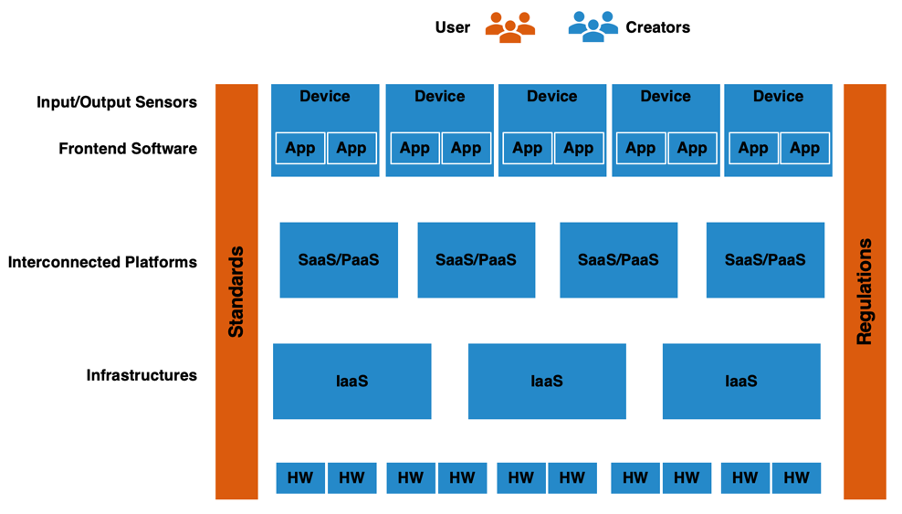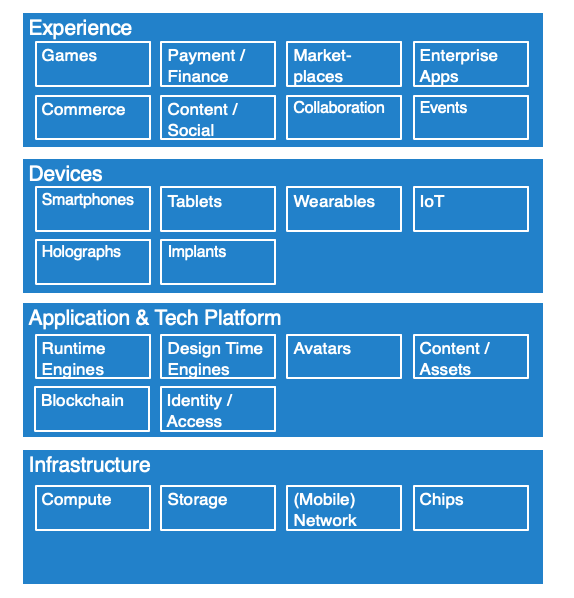This is the third part of my return of the undead series. The first two parts dealt with identifying what components or building blocks a metaverse ecosystem needs to consist of. These components basically define how metaverse can work and serve as a model for the identification of how/where participants in an ecosystem could earn their revenues.

These building blocks are mainly independent of the notion of a(n open) metaverse, as described by Tony Parisi in his article The seven Rules of the Metaverse. They also apply to a more multiverse type world of a collection of closed metaverses – something that I really do not want to call metaverse.
The openness, that is necessary for a “metaverse” to thrive can be achieved either by common consent or via regulation – or more likely by a combination thereof. In any case, I believe that some amount of regulation is necessary in order to create and maintain a level playing field and to avoid one or few companies hijacking the area – as this is a platform game and platform games prefer size and allow only few dominant players.
- Users and creators use front-end applications that enable them to create the and interact with the virtual worlds that are offered. It is here, where the experience happens.
- These applications run on devices that offer the necessary sensors and actuators.
- The front-end applications connect to one or more virtual worlds that are provided as a service and that themselves rely on technology platforms.
- All this gets connected by an infrastructure that includes servers, storage, networks, chips, etc, as well as the necessary services around them.
Besides my framework, other people or organizations have developed own value chains, e.g., Jon Radoff or Sciencx, to name only two.
In the second article of this mini-series, I searched for compelling use cases that support both, B2B and B2C scenarios. As you can imagine, especially the use case frontier is quite difficult. What we see is a whole lot of use cases that base on existing, sometimes quite innovative, technology which gets quickly rebranded using the “metaverse” moniker.
The whole topic is still evolving, and we are in a situation that can remind us of the gold rush at Klondike: A stampede of hopefuls rush into the “area” with big hopes of getting rich.
We all know what happened back then.
As I laid out in my article, the currently existing metaverse use cases are mainly focusing on the concept of NFTs and around applying real world concepts, especially scarcity, to the digital world. They mainly address consumers, real estate and retail. B2B use cases are far less evolved and often include statements like “in future”. Another observation is that many existing technologies and solutions are quickly relabeled to leverage the metaverse traction. It is not too difficult to find several year-old demos on e.g., VR and AR, that didn’t use the term metaverse. Except, now they do. The same can be observed for the more recent phenomena of blockchain and NFT.
The good news is that they topical hype seems to subside.
All this brings us to an interesting question.
Who will rule?
“One Ring to rule them all,
One Ring to find them,
One Ring to bring them all
And in the darkness bind them.”
From the Lord of the Rings
To get an idea about a possible answer, it is useful to have a look at above diagram from a slightly different angle and organize it around what happens on which layer. This gives an idea of what services and hence which value vendors on the various layers create for customers.

The diagram could be broken down into further layers, but these four should suffice. This way, we can visualize for ourselves, where there are opportunities for metaverse players. The diagram does not claim to be complete in any way, when it comes to the embedded boxes, which indicate the services that are on which layer.
- The experience layer holds the applications and services that users and creators are consuming or creating on the devices that they are using,
- which form the next layer.
- Via the devices and apps a lot of (cloud) services can be created and consumed that live on the application and technology platform. Think of this as a combination of SaaS and PaaS layer.
- Lastly, we have the physical infrastructure that runs the whole thing.
The boxes in the four layers are of course indicative only and do not claim any completeness.
However, what is clear is that there are multiple players in each of these boxes, specialists as well as generalists. Some players do appear in multiple boxes and in more than one layer.
As figure 1 shows, the metaverse market is an ecosystem play. Ecosystem markets automatically put players at an advantage that already have and/or offer reach, offer a platform for other market participants or are infrastructure players. Of critical interest in this ecosystem are players that provide access to very low latency and high bandwidth mobile communications and those who own the IP for relevant chips.
This seems to favor big companies like telcos and ISPs as well as Microsoft, Google, Meta, Roblox, etc. which already have achieved quite some scale. Or companies like Nvidia, which produces the necessary chips; or ARM, which develops and holds a lot of the IP that is necessary to build these chips.
On the other hand, big companies often have a challenge with (disruptive) innovation.
Why?
This is a structural challenge. It is not that big companies are less innovative than small companies per se. However, they often need to answer to their shareholders on a frequent basis and therefore to provide fast returns with relatively high margins for every investment, to protect their valuations.
This favors nimble startups and VC companies who enjoy more slack when it comes to fast returns. Some of the startups in the relevant areas will either develop for a niche or sector and be successful – or they will be acquired by bigger players.
So, who will it be?
Neither! Or actually most of them.
This might surprise you, but the answer is quite simple – and obvious from the waning popularity of the term. Some big companies didn’t even jump on the train.
Let’s count some reasons:
- The term as such was over-hyped. There is no real concept or overarching value proposition associated with it.
- In the next years we will not see the necessary standardization that would be necessary to deliver on any broader concept. Given this, vendors will concentrate on their patches.
- Most technologies that are currently touted as “metaverse” technologies existed and often thrived before the term got hyped. They will continue to develop and many of them successful. The overarching dream of “metaverse” is simply not necessary.
- Companies will fall back to concrete/specific use cases in which technologies can help solving the issue at hand. This might be a combination of VR/AR and IoT, or robotics, telepresence, holograms, digital twins, sometimes blockchains, etc., in different combinations.
I do think that this would be a good development. The appetite for innovation has been spurred by the hype, interesting use cases that solve actual problems will be solved. These solutions will connect as necessary.
This is business as usual.
What do you think? Let me know!

